by Dr. Noel Kingsbury
Dr. Kingsbury, British plantsman and author, presents “Plant Morphology: Guide to Predicting Plant Performance” at an ELA Intensive Workshop, November 20, 2015 at Longwood Gardens.
Many gardeners and garden and landscape design professionals are frustrated by the limited amount of information given in plant reference books, particularly about the long-term performance of herbaceous perennials. We have all had the experience of plants that are described as perennials but die after a couple of years, or of plants that take ages to establish, or that seed around to an extent that can make us regret ever having bought them. Those who use plants professionally, for clients who need reliable results, find this especially problematic. Indeed lack of knowledge about long-term performance may actively discourage many professionals from using herbaceous perennials.
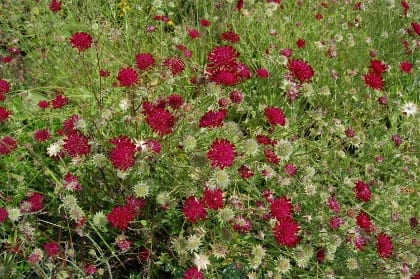
Knautia macedonica is popular in all its various colour forms. It is reported as relatively short-lived, but compensates through frequent self-seeding.
Go to many an amateur garden group however, or gather together any group of gardeners, and there is a buzz of information being exchanged, much of it about just these questions of long-term performance: “spreads like crazy, doesn’t say that on the label”, “always dies after three years”, “it self-seeds in my neighbours’ garden but never mine.” It was to try to gather together some of the information from this ‘anecdotal cloud’ that I applied for funding from a European Union-supported project which the Department of Landscape at the University of Sheffield had joined. The project concerned was an ‘MP4’, where practitioners in a particular field compare and contrast best practice across national boundaries; this particular project was designed to look at the cost-effectiveness of the management of public space. My proposal was that I should design a simple questionnaire on long-term plant performance and persuade experienced gardeners to fill it in, in order to gain more insight into some key questions about common perennials.
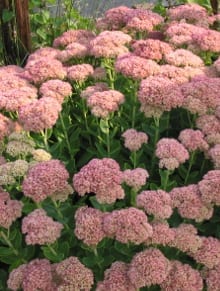
Sedum (Herbstfreude Group) ‘Herbstfreude’ comes out as a reliably long-lived, and relatively trouble-free plant.
Information gained in the amateur sector can then be transferred to the professional. Since doing the study, I have been able to do extensively: running workshops in Buenos Aires, Portland, Prague, Moscow, Kiev, and many locations in the U.K.
A note in a number of journals of horticultural membership organisations and the newsletter of the Professional Gardeners Guild resulted in a total of 66 completed questionnaires. Judging from the replies and from covering letters, many were very experienced gardeners – it felt marvellous to be able to tap into the knowledge of people with 20 or even 30 years’ experience of growing particular species. Many participants said how much they enjoyed taking part, as it made them think about their plants in a new way.
Participants were asked to select plants from a list of nearly 100 perennials – all plants about which I had already collected a considerable amounts of data from research I had conducted doing a PhD in the Landscape Department at Sheffield University. Of the plant species and varieties which participants chose to answer questions on, 62 had at least ten responses, which I judged was enough data to analyse. The overall picture confirms and illustrates something to which I have devoted much thought over the years – that herbaceous perennials fall into some definite, but overlapping and cross-cutting, categories. More useful knowledge for the gardener than categories, however, are the differences in the various performance criteria.
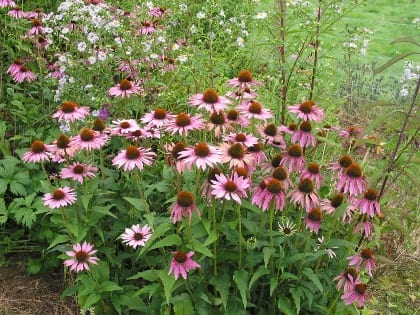
Echinacea purpurea and its various hybrids is now a very popular plant. Respondents however gave it the lowest rating for longevity, and a low rating for competitive ability. Sometimes short-lived species are reliable self-seeders, but not this one!
Longevity
Some ‘perennials’ really do die very quickly – in everyone’s gardens, not just yours! The data showed that there is a gradient of longevity – from the ephemeral to those species which nurseryman Bob Brown describes as ‘bomb-proof’ (certain geraniums; hostas, despite the slugs; Acanthus mollis; and Miscanthus grasses. A great many others which would also appear to be long-lived but occasionally fail. Then there are those which definitely appear to be inherently short-lived; some of the worst are varieties of Echinacea, Achillea, Heuchera, and Monarda. There are also those which are short-lived but in many gardens continue to reproduce themselves with seedlings (albeit sometimes too enthusiastically), e.g. Knautia macedonica and Aquilegia vulgaris.
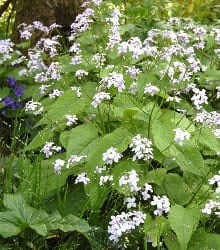
Euphorbia cyparissias is notorious as an aggressive spreader, but is easily outcompeted by taller plants. Respondents in fact reported wide variations in how extensively it spread; they either found the habit useful or regretted ever having introduced it to their gardens.
Looking at the data, my conclusion is that we need to distinguish between perennials that spread vegetatively, forming clumps composed of large numbers of shoots each with their own roots, and therefore potentially an independent plant, and those which do not. The latter may include many, such as the border sedums and Salvia x superba and relatives, that may be long-lived but which will always be vulnerable to damage because they do not form a constantly spreading clump. Those that are definitely short-lived are nearly always distinguishable by the single connection between their roots and the top growth. Consequently, I believe that anyone examining an unfamiliar perennial for the first time could predict its longevity from paying close attention to the way the roots and shoots connect.
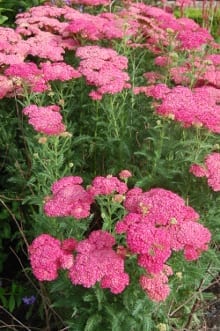
Achillea (Galaxy Series) All achilleas were reported to be relatively short-lived, and uncompetitive, although experience would appear to vary widely, particularly with longevity.
Learning to recognise the potential longevity of perennials is important, as the nursery industry currently seems to favour producing new varieties from several genera which seem to be inherently short-lived. Hybrids of Echinacea are a good case in point. It is, of course, in the interests of the retail nursery industry to produce short-lived plants, but it would be nice to be given a clearer and more honest assessment of expected longevity on the label! For those interested in genuine longevity, and particularly those who are responsible for spending public money, this is an area of key interest. In my final report I criticise the nursery industry for not putting enough effort into developing and promoting new varieties of reliably long-lived and robust perennials. It would also help greatly if we all recognised a new category: short-lived perennials.
Vegetative Spread
Following on from what has just been said, we can expect perennials to spread at different rates. Ecologists use two rather military terms to describe the ways in which spreading species achieve their aims: phalanx, where the plant moves outwards on a solid front and guerrilla, where odd runners are sent out over relatively long distances. The latter approach, familiar to many of us from Euphorbia cyparissias, can be seen either as a nuisance or a useful way of filling space – depending on one’s gardening style! The research has helped to clarify which popular perennials used which type of spread. It also confirmed the link between the effective reach of vegetative spread and two other factors: longevity and a relative lack of self-seeding ability. There is a clear trade-off here – a plant which spreads effectively through runners or rhizomes tends not to self-seed. The exception is Geranium x oxonianum. The variety ‘Claridge Druce’ is a spectacular example in the experience of several research participants, as it runs and can self-seed profusely.
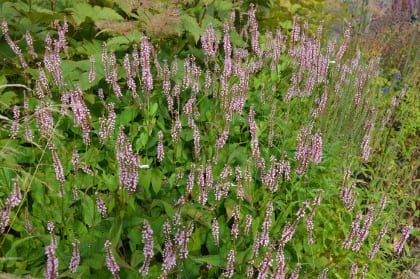
Persicaria amplexicaulis ‘Rosea’; the species is reported by participants in the study as strongly spreading and reliably long-lived.
Sometimes there appears to be a wide divergence in experience. Some gardeners, for example, report spreading by runners in Centaurea montana, others do not; quite possibly there are different forms in cultivation that behave differently, which we might expect from a species that has probably been introduced into cultivation several times over. This was another issue that came up several times in the project – that there are differences in the level of genetic variation amongst garden plants: named hybrids and cultivars are (or should be) identical, species may be derived from a single introduction and thus show little variation, or from multiple introductions when we would expect more variation.
Competitiveness
The ability of a plant to compete with others in the garden is clearly related to its spreading ability. The following were the species that respondents recorded as being the most likely to spread and smother neighbours: Lysimachia clethroides, Acanthus mollis, Persicaria bistorta ‘Superba’, Geranium x oxonianum types, Macleaya cordata and Euphorbia cyparissias. Plants most likely to be smothered were almost invariably non-spreaders and quite often short-lived too, such as Echinacea purpurea. However many species that seem reliably long-lived are not greatly competitive, such as Amsonia orientalis and Baptisia australis.
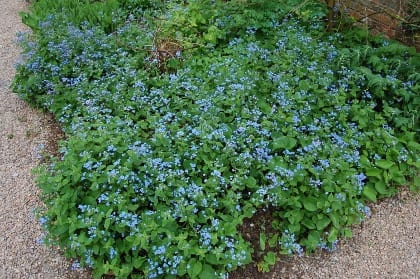
Brunnera macrophylla was generally reported to be long-lived and moderately competitive. The species appears to self-seed in many gardens; named cultivars appear to do this less often.
Speed of Establishment
Most perennials establish quickly, but not all, and in some cases reliably long-lived and/or relatively competitive species may be slow to get going, and because of this may fail in their first couple of years, either because of competition or vulnerability to various environmental stresses; examples are Amsonia orientalis, Anemone x hybrida, Baptisia australis, Helleborus x hybridus, Iris sibirica, and Liriope muscari. Evidence from other sources, both technical and anecdotal, indicates that what these plants are doing is investing in extensive root-systems in their early years; this habit appears to be of benefit later, as many are notably long-lived and resilient plants.
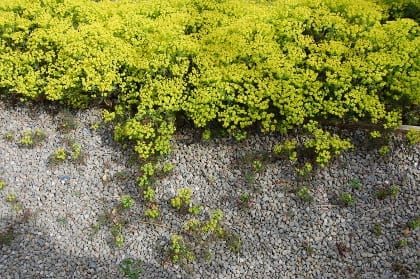
Euphorbia cyparissias is notorious as an aggressive spreader, but is easily outcompeted by taller plants. Respondents in fact reported wide variations in how extensively it spread; they either found the habit useful or regretted ever having introduced it to their gardens.
Self-seeding
For some gardeners self-seeding is a curse, either because soil types favour the germination of every seed which hits the ground, or because the tidier-minded do not appreciate so much spontaneity; for others it is a blessing, as it can result in the development of a dynamic and natural-feeling planting. Where species tend to be short-lived, such as Aquilegia vulgaris, it is important for their survival in the garden, but it may be a nuisance if they are also spreaders through vegetative growth, as with Alchemilla mollis and some of the more strongly-spreading geraniums. Some species, which are not spreaders and have a physically quite narrow profile, can self-seed extensively and create attractive mass effects as they do so, as with Geranium sylvaticum, Lunaria rediviva and Thalictrum aquilegifolium. Few of us begrudge the extensive seedling production of Helleborus x hybridus either.
This survey was also an interesting, although very limited, opportunity to assess the popularity of perennials with experienced gardeners. The top five, in descending order, were Helleborus x hybridus, Alchemilla mollis (viewed either as indispensable or hated for its seeding abilities), varieties of Crocosmia (although there appears to be a huge variation in hardiness between different cultivars), and varieties of Miscanthus sinensis and of Pulmonaria.
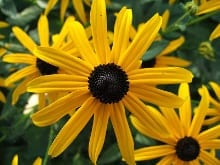
A number of different forms of Rudbeckia fulgida are in cultivation, all appearing to be long-lived and with a moderately spreading habit. One of those plants for which no one had a bad word. Photo: Jerzy Opioła.
My experience with this project has convinced me that it is possible to gather together the extensive, but often very disparate, knowledge that gardeners have and to draw useful conclusions from it. Such conclusions can then be useful for professional as well as amateur gardeners. I am very interested in carrying out further research using this methodology, though as ever that will depend on funding, so I may well be appealing to your generosity in sharing your great fund of knowledge and experience again.
If you would like to contribute to possible future research, or would like a copy of the full report then please contact me via my blog: noels-garden.blogspot.com.
Summary
The ten plants most frequently reported as being short-lived (most often short-lived first):
Echinacea purpurea and hybrids
Achillea interspecific hybrids
Aquilegia vulgaris, and cvs.
Achillea millefolium cvs.
Heuchera micrantha and hybrids
Monarda hybrids
Knautia macedonica, and cvs.
Dictamnus albus, and cv.
Anemanthele lessoniana
Aster x frikartii ‘Mönch’
Plants always reported as being reliably long-lived:
Geranium x oxonianum types
Hosta, various taxa
Geranium sylvaticum cvs.
Acanthus mollis
Liriope muscari, and cvs.
Miscanthus sinensis, and cvs.
The ten top spreaders by vegetative means (greatest spreading ability first):
Euphorbia cyparissias and cvs.
Macleaya cordata
Persicaria bistorta ‘Superba’
Persicaria amplexicaulis and cvs.
Filipendula rubra and cvs.
Lysimachia clethroides
Monarda hybrids
Anemone x hybrida cvs.
Geranium x oxonianum types
Phlomis russeliana
The ten species reported as being the slowest to establish (slowest to establish first):
Dictamnus albus, and cvs.
Baptisia australis
Amsonia orientalis
Anemone x hybrida and cvs.
Geranium renardii and cvs.
Helleborus x hybridus
Aster x frikartii ‘Mönch’
Euphorbia polychroma and cvs,
Liriope muscari, and cvs.
Iris sibirica cvs.
The ten species reported as being the most effective self-seeders (the most effective first):
Aquilegia vulgaris, and cvs.
Alchemilla mollis
Anemanthele lessoniana
Helleborus x hybridus
Geranium x oxonianum types
Brunnera macrophylla
Geranium pratense and cvs.
Centaurea montana, and cvs.
Lunaria rediviva
Thalictrum aquilegifolium, and cvs
About the Author
Dr. Noel Kingsbury is internationally known as an innovator and author. He has worked on both private gardens and public spaces developing nature-inspired planting, and has written about garden design, green roofs, and the politics of gardening. A great believer in using science to inform our gardening, he completed a PhD with the University of Sheffield in 2008 with a focus on the selection and management of ornamental perennials. In addition to taking on his own design projects, Dr. Kingsbury writes for the UK and US garden press and has written 20 books. His latest publication, Plant Selection: Learning From Nature is a reference for landscape architects and designers to help select plants that are ecologically suited to the site. In between traveling widely, and continuing his plant research, he gives plants and gardens trial runs at his home on the England/Wales border.

